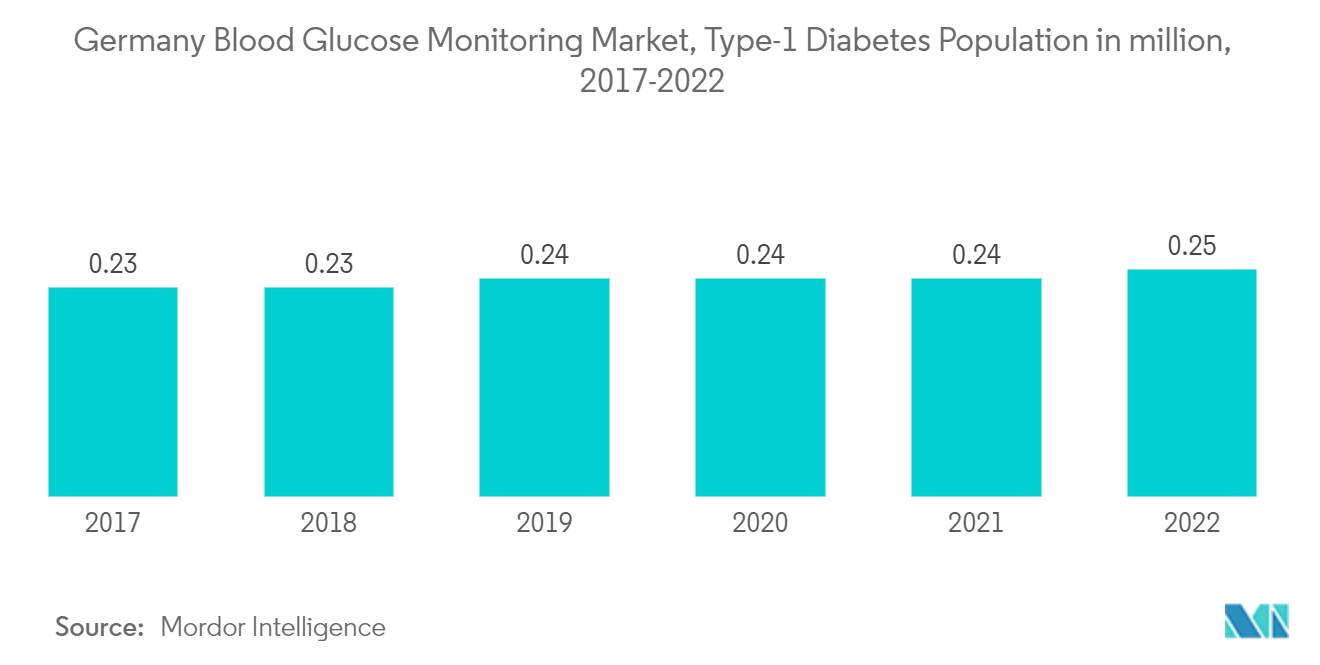Market Trends of Germany Blood Glucose Monitoring Industry
Rising diabetes prevalence is likely to boost the market studied over the forecast period.
In Germany, the diabetes population is expected to increase with a CAGR of about 0.48% over the forecast period.
According to the German Diabetes Centre (DDZ) 2022, about 8.5 million people in Germany are affected by diabetes. The number of people with type 2 diabetes in Germany will continue to increase over the next twenty years. Researchers at DDZ estimate that up to twelve million people might suffer from metabolic disorders in 2040.
According to European Observatory on Health Systems and Policies 2021, Germany has the oldest social health insurance system. Health insurance is compulsory. People with an income above a fixed threshold or belonging to a particular professional group can opt out of social health insurance coverage and enroll in private health insurance. About 11 % of the population is covered by private health insurance, 89% by social health insurance. Although coverage is universal for all legal residents, only 0.1 % of the population does not have health insurance.
Diabetes can be considered a data management disease, and an example of real-world acquisition of health and treatment data informs an integrated and personalized chronic disease management. Both patients and diabetes care providers use continuously collected metabolic, treatment, and lifestyle data in joint decision-making on treatment-digital health technologies, including digital health applications, support diabetes self-management.
The vast range of apps in the diabetes field supports the adoption of lifestyle interventions for the prevention and management of diabetes, the evaluation of blood glucose control quality, and the dosing of insulin. Integration of Blood Glucose Monitoring with insulin calculators, automated insulin titration software, and remote coaching are further developments that provide patients with poorly controlled diabetes additional support needed to improve critical outcomes, thereby enhancing the market prospects in the years to come.

The continuous glucose monitoring segment is expected to witness the highest growth rate over the forecast period
The Continuous Glucose Monitoring Segment is expected to witness the highest CAGR of 10.7% over the forecast period.
Continuous glucose monitoring sensors use glucose oxidase to detect blood sugar levels. Glucose oxidase converts glucose to hydrogen peroxidase, which reacts with the platinum inside the sensor, producing an electrical signal to be communicated to the transmitter. Sensors are the most important part of continuous glucose Monitoring. Technological advancements to improve the accuracy of the sensors are expected to drive segment growth during the forecast period.
Researchers are trying to find and develop alternatives to electrochemical-based glucose sensors and create more affordable, minimally invasive, and user-friendly CGM sensors. Optical measurement is a promising platform for glucose sensing. Some technologies have been reported to have high potential in continuous glucose sensing, including spectroscopy, fluorescence, holographic technology, etc. Eversense, a CGM sensor based on fluorescence sensing developed by Senseonics Company, presents a much longer lifespan than electrochemical sensors.
The frequency of monitoring glucose levels depends on the type of diabetes, which varies from patient to patient. Type-1 diabetic patients need to check their blood glucose levels regularly to monitor their blood glucose levels and adjust the insulin dosing accordingly. The expenditure incurred by Type-1 diabetic patients on these devices is nearly double that of Type-2 diabetics. The current CGM devices show a detailed representation of blood glucose patterns and tendencies compared to a routine check of glucose levels at set intervals.
Furthermore, the current continuous glucose monitoring devices can either retrospectively display the trends in blood glucose levels by downloading the data or give a real-time picture of glucose levels through receiver displays. The newest CGM models, the Abbott Freestyle Libre 3 and the Dexcom G7, overcame many technical barriers. Continuous glucose monitoring devices are becoming cheaper with the advent of new technologies, like cell phone integration, which is likely to drive the segment growth during the forecast period.


